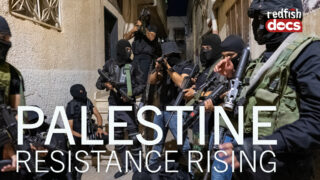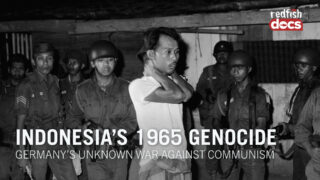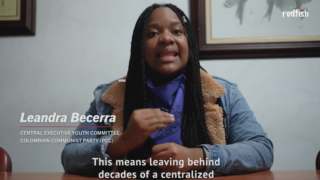Afeni Sh., social justice advocate
On May 15, 2018, the Allgemeine Zeitung, a German-language newspaper based in Namibia, published an article suggesting that redfish’s two-part report on inequality, land and race in Namibia was one sided. They even went as far as to say that the report actively tried to stir up racial animosity in Namibia. This is quite a claim, and the author of the article must have been living under a rock if they think that this animosity isn’t there already in great abundance.
The article also claims that redfish didn’t take into account how much inequality has fallen in Namibia since the country gained independence from Apartheid-era South Africa in 1990. Ironically, this same newspaper published photos of the German Carnival in Namibia that showed people in KKK outfits and ‘black face’, which it described as “very resourceful” rather than horribly racist. This kind of tone deaf ignorance and insensitivity is, in my experience, rampant in the German community.
As a black Namibian, I can testify that little has changed in the country for blacks or whites since Apartheid formally ended and too little has been done since Namibia gained independence in 1990 to undo the immense, deeply entrenched inequality that scars the country. The country’s white minority still owns a grossly disproportionate percentage of Namibian land and government attempts at redistribution have fallen well short of what is required to correct the injustices of the colonial era. Indeed, it could be argued that they actually perpetuate these injustices. Let me explain.
INDEPENDENCE BETRAYED
On May 4, 1978 an air raid on a refugee camp in southern Angola by Apartheid South Africa’s military left up to 600 dead. Most of the casualties were women and children. In Namibia, the colonial situation had made life so unbearable that many fled to join the revolutionary armed resistance: SWAPO. The Apartheid government claimed that the massacre was an attack on a SWAPO military base, but the Namibian people remember it as one of the most horrifying atrocities in the history of the 24 year-long struggle for independence. Cassinga Day, named after the location of the massacre, is commemorated in Namibia every year. Casualties were only limited by the presence of Cuban soldiers stationed nearby who rushed to defend and evacuate the remaining refugees out of the camp, some of whom only survived by hiding among the corpses. The attack on Cassinga showed the world the callous brutality of the Apartheid regime. It also made the Namibian people more determined to reclaim their land from the country’s white minority.
Communists and Pan-Africanists from the region and further afield aided the Namibian forces in their war of liberation, which ended in March 1990 – four months after the fall of the Berlin Wall. As governments aligned to the Soviet-bloc fell all across the world, the socialist agenda that guided the Namibian liberation struggle became so sidelined that the country’s new constitution included a clause that enshrined the protection of private property. This clause would entrench colonial-era inequality in Namibia as almost all the country’s private property was owned by white people, who made up less than 6% of the population. The aftereffects of this clause continue to plague Namibia today.
GERMANS AND GENOCIDE
After Germany’s defeat in World War I, Adolf Hitler, a soldier needing a scapegoat, popularized fascist nationalism by blaming Jewish, socialist and communist communities in Germany for aiding the country’s defeat from within. A little known fact in Europe is that the leading architects of the European holocaust drew from their experience of genocide in Namibia. As was the fashion in those times, the African continent was used as a testing ground for social experiments that were later imported to Europe. This time, the project was the death camp. To Europeans, the racist idea that black people were subhuman justified the land grabbing that became central to Germany’s obsession with “Lebensraum” and which had helped advance whites in Namibia into a superior class status.
In 1884 Namibia became a German Protectorate and the colonial administration coerced local chiefs into giving the German government and German companies rights to use the land. The Germans quickly got greedy, taking over huge swathes of land and dispossessing the indigenous people in record time. The Ovaherero people, a semi-nomadic tribe which traditionally lived from tending livestock, resisted and were met with General von Trotha’s “Vernichtungsbefehl”; an extermination order for genocide of the Herero tribe. After losing their land, many went on to die from over-exhaustion in slave labour concentration camps while others died of thirst in the Omaheke (Kalahari) Desert where thousands were driven. General von Trotha extended this genocidal barbarity to the Nama people who continued resisting foreign occupation on their lands. During this time, German commercial land ownership shot up by a staggering 15% while African communal land decreased by more than 20%.
Namibia remained under German control until 1915, when Germany was stripped of its colonies in the aftermath of World War I. Namibia eventually ended up in the hands of Apartheid South Africa via a deal with the British. The colonial regime of South Africa introduced a policy of settling poor South African whites in Namibia and handing them vast tracts of land to sustain themselves. This policy was a catastrophe for the indigenous people leading to further displacement on a huge scale. Between 1925 and 1960 roughly 39 million hectares – an area bigger than the whole of Germany– was expropriated from the natives (and yes, without compensation).
By 1990, almost half of the country’s land was under white ownership. A land conference was held in 1991 to tackle the inequalities created by this lopsided allocation of territory, but the end result was a huge disappointment. The Namibian government rejected calls for land expropriation from whites and instead announced a market-based “willing seller, willing buyer” policy. This policy gave the government the first option on any land that appeared on the market, which it could then buy from white landowners and redistribute it amongst the poorest segments of Namibian society. Its results, however, fell wildly short of the government’s expectations: According to News24, “the Namibian government planned to give 15 million hectares of commercial farmland to previously disadvantaged Namibians by 2020”. But as of 2015, only “2.6m hectares have been bought”.
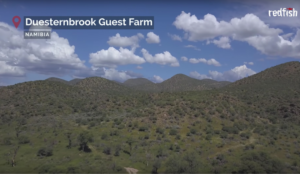

NO KIND OF SOLUTION
The ‘willing seller, willing buyer’ policy failed for a myriad of different reasons. Firstly, white landowners have successfully taken the government to court to avoid paying a proposed “land tax” which was supposed to provide funding for the government to buy back land for native populations. In addition to this, white landowners have found ways to avoid selling their farms to the government by transferring land ownership into the hands of closed corporations. This can only be described as willful sabotage. When the government amended the law to cover this loophole, land increasingly got transferred into family trusts, which further obstructed the sales. But it’s not only white landowners that are the problem.
By 2002 only 1% of commercial land had been redistributed. Today, decades after independence and more than a century after formal German colonisation ended, the best farmland is still in the hands of the descendants of settler colonialists.
ENOUGH IS ENOUGH
The living standards of many of Namibia’s dispossessed remain shockingly low. Today, up to one third of the Namibian population live in sub-serviced shanty areas. Deceptively described as “informal settlements”, these slums have worse facilities than a typical UNHCR emergency refugee camp. But change appears to be on its way: new leaders like Job Amupanda, a former SWAPO [South West African People’s Organisation] youth leader who now heads the Affirmative Repositioning group, and the former Deputy Minister of Land, Bernadus Swartbooi, who leads the Landless People’s Movement, are heading the fight back.
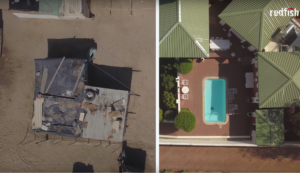

Both leaders and their respective supporters are tired of the government’s ineffective attempts at land reform, as well as the reluctance of the white stakeholders to come to the negotiating table with serious proposals in the spirit of reconciliation and equality. The repeated failure to find a political solution by diplomatic means is feeding calls for land expropriation from whites by any means necessary, including without compensation.
As we can observe in settler colonies such as the USA, Australia and, more recently, Israel, denying indigenous peoples their land strips them of their sovereignty and self-determination. As long as land, which in Fanonian terms is tied up not just to the colonized peoples’ bread but also to their dignity, remains largely privatized and in the hands of a foreign minority, the decolonization process is incomplete and it can only begin completion when the resources are returned to the people.


